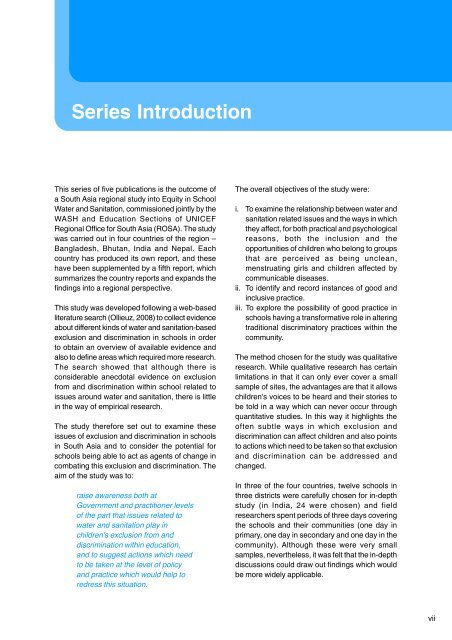Equity in School Water and Sanitation
Equity in School Water and Sanitation
Equity in School Water and Sanitation
Create successful ePaper yourself
Turn your PDF publications into a flip-book with our unique Google optimized e-Paper software.
Overcom<strong>in</strong>g Exclusion <strong>and</strong> Discrim<strong>in</strong>ation <strong>in</strong> South AsiaCountry Report BhutanSeries IntroductionThis series of five publications is the outcome ofa South Asia regional study <strong>in</strong>to <strong>Equity</strong> <strong>in</strong> <strong>School</strong><strong>Water</strong> <strong>and</strong> <strong>Sanitation</strong>, commissioned jo<strong>in</strong>tly by theWASH <strong>and</strong> Education Sections of UNICEFRegional Office for South Asia (ROSA). The studywas carried out <strong>in</strong> four countries of the region –Bangladesh, Bhutan, India <strong>and</strong> Nepal. Eachcountry has produced its own report, <strong>and</strong> thesehave been supplemented by a fifth report, whichsummarizes the country reports <strong>and</strong> exp<strong>and</strong>s thef<strong>in</strong>d<strong>in</strong>gs <strong>in</strong>to a regional perspective.This study was developed follow<strong>in</strong>g a web-basedliterature search (Ollieuz, 2008) to collect evidenceabout different k<strong>in</strong>ds of water <strong>and</strong> sanitation-basedexclusion <strong>and</strong> discrim<strong>in</strong>ation <strong>in</strong> schools <strong>in</strong> orderto obta<strong>in</strong> an overview of available evidence <strong>and</strong>also to def<strong>in</strong>e areas which required more research.The search showed that although there isconsiderable anecdotal evidence on exclusionfrom <strong>and</strong> discrim<strong>in</strong>ation with<strong>in</strong> school related toissues around water <strong>and</strong> sanitation, there is little<strong>in</strong> the way of empirical research.The study therefore set out to exam<strong>in</strong>e theseissues of exclusion <strong>and</strong> discrim<strong>in</strong>ation <strong>in</strong> schools<strong>in</strong> South Asia <strong>and</strong> to consider the potential forschools be<strong>in</strong>g able to act as agents of change <strong>in</strong>combat<strong>in</strong>g this exclusion <strong>and</strong> discrim<strong>in</strong>ation. Theaim of the study was to:raise awareness both atGovernment <strong>and</strong> practitioner levelsof the part that issues related towater <strong>and</strong> sanitation play <strong>in</strong>children's exclusion from <strong>and</strong>discrim<strong>in</strong>ation with<strong>in</strong> education,<strong>and</strong> to suggest actions which needto be taken at the level of policy<strong>and</strong> practice which would help toredress this situation.The overall objectives of the study were:i. To exam<strong>in</strong>e the relationship between water <strong>and</strong>sanitation related issues <strong>and</strong> the ways <strong>in</strong> whichthey affect, for both practical <strong>and</strong> psychologicalreasons, both the <strong>in</strong>clusion <strong>and</strong> theopportunities of children who belong to groupsthat are perceived as be<strong>in</strong>g unclean,menstruat<strong>in</strong>g girls <strong>and</strong> children affected bycommunicable diseases.ii. To identify <strong>and</strong> record <strong>in</strong>stances of good <strong>and</strong><strong>in</strong>clusive practice.iii. To explore the possibility of good practice <strong>in</strong>schools hav<strong>in</strong>g a transformative role <strong>in</strong> alter<strong>in</strong>gtraditional discrim<strong>in</strong>atory practices with<strong>in</strong> thecommunity.The method chosen for the study was qualitativeresearch. While qualitative research has certa<strong>in</strong>limitations <strong>in</strong> that it can only ever cover a smallsample of sites, the advantages are that it allowschildren's voices to be heard <strong>and</strong> their stories tobe told <strong>in</strong> a way which can never occur throughquantitative studies. In this way it highlights theoften subtle ways <strong>in</strong> which exclusion <strong>and</strong>discrim<strong>in</strong>ation can affect children <strong>and</strong> also po<strong>in</strong>tsto actions which need to be taken so that exclusion<strong>and</strong> discrim<strong>in</strong>ation can be addressed <strong>and</strong>changed.In three of the four countries, twelve schools <strong>in</strong>three districts were carefully chosen for <strong>in</strong>-depthstudy (<strong>in</strong> India, 24 were chosen) <strong>and</strong> fieldresearchers spent periods of three days cover<strong>in</strong>gthe schools <strong>and</strong> their communities (one day <strong>in</strong>primary, one day <strong>in</strong> secondary <strong>and</strong> one day <strong>in</strong> thecommunity). Although these were very smallsamples, nevertheless, it was felt that the <strong>in</strong>-depthdiscussions could draw out f<strong>in</strong>d<strong>in</strong>gs which wouldbe more widely applicable.vii












